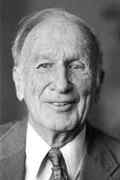Person: Lorenz, Edward

Edward Lorenz was an American mathematician and meteorologist first recognised the phenomenum of chaos in complex systems.
Mathematical Profile (Excerpt):
- After the award of his master's degree, Lorenz undertook war service with the United States Army Air Corps.
- Lorenz had been employed as an assistant meteorologist at the Massachusetts Institute of Technology from 1946, but when he was awarded his doctorate in 1948 he was promoted to meteorologist.
- Lorenz spent his whole career at the Massachusetts Institute of Technology, being appointed assistant professor in 1954, then promoted to associate professor before becoming Professor of Meteorology in 1962.
- It was a simple event in 1961 which led Lorenz to results which brought him worldwide fame.
- Lorenz had discovered chaos.
- Lorenz was not the first person to discover chaos.
- Now that Lorenz understood the significance of his discovery he wrote it up in the paper Deterministic Nonperiodic Flow and it appeared in the Journal of the Atmospheric Sciences in 1963.
- The set of equations and the attractors described by this set of equations are now called the 'Lorenz equations' and 'Lorenz attractors', respectively.
- It would be fair to say that Lorenz began a scientific revolution with this paper which he and many others developed over the following years.
- By encapsulating the essence of chaos theory in the title of his talk, Lorenz succeeded in capturing the public's imagination and the term "butterfly effect" was soon the popular term for chaos.
- Another account of aperiodic behaviour in ordinary differential equations, and difference equations, in which Lorenz describes how he arrived, starting from the description of convection in meteorology, at the Lorenz equations is contained in his paper On the prevalence of aperiodicity in simple systems delivered at the Biennial Seminar of the Canadian Mathematical Congress in Calgary, Canada, in 1978.
- Later papers include: A very narrow spectral band (1984) which investigates the spectral properties of the Lorenz system; The local structure of a chaotic attractor in four dimensions (1984); Lyapunov numbers and the local structure of attractors (1985); On the existence of a slow manifold (1986); Atmospheric models as dynamical systems (1986); Computational chaos - a prelude to computational instability (1989); and The slow manifold - what is it?
- In 1991 Lorenz gave the Jessie and John Danz Lectures at the University of Washington.
- In measured tones, Lorenz starts slowly and builds up gradually a complete understanding of chaos.
- Lorenz received many awards and honours for his remarkable contributions.
Born 23 May 1917, West Hartford, Connecticut, USA. Died 16 April 2008, Cambridge, Massachusetts, USA.
View full biography at MacTutor
Tags relevant for this person:
Analysis, Origin Usa
Thank you to the contributors under CC BY-SA 4.0! 

- Github:
-

- non-Github:
- @J-J-O'Connor
- @E-F-Robertson
References
Adapted from other CC BY-SA 4.0 Sources:
- O’Connor, John J; Robertson, Edmund F: MacTutor History of Mathematics Archive
